#poststructualism
Text
Reading Notes 5: Baudrillard to Jameson
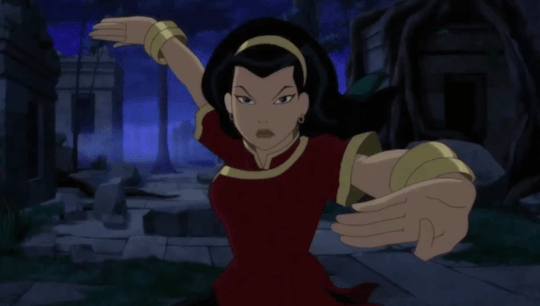
To further our studies in visual analysis, Jean Baudrillard’s “Simulacra and Simulations” and Fredric Jameson’s “Postmodernism and Consumer Society” offer guidance to understanding the roles of poststructuralism and postmodernism.
What are the four successive phases that break down an image?
What is the relationship of parody to the object it mocks, and at what point does parody become impossible and pastiche appear?
@theuncannyprofessoro
16 notes
·
View notes
Text
Analytical Application 3: Poststructuralism and Postmodernism
Difference: Gilles Deleuze
Definition: Giles Deleuze writes in "Introduction: Repetition and Difference," that the term "difference" is a fundamental idea in his writings and he describes it as not a way to measure the distance between two things, but actually an existential ideology of abundance and growth. Deleuze writes how this does not create stability and instead focuses on the atypical aspects of reality.
Analysis: In Gilles Deleuze's "Introduction: Repetition and Difference," he writes about his understanding of the term "difference," by suggesting it should be a basic concept in society, not just by its literal definition. Deleuze speaks on how difference is inherent in the very essence of reality, far more than just the difference of two people as an example. He says that difference creates diversity. We see this idea in "Run Lola Run" (1998), directed by Tom Tykwer. In the scene where Lola runs into a homeless man on the street, Deleuze’s concept of difference is exemplified (00:17:43). Specifically, Lola is sprinting down the street while the homeless man is walking in the other direction. She is focused on the task at hand to save her boyfriend Manni. The homeless man juxtaposes the motion of Lola. The bustling streets around him as well as Lola don't affect him.
Delezue’s idea is that difference is what makes individuality stand out. “Run Lola Run” compares the diversity of the city by examining many different people and their differences. The encounter with the homeless man shows how people coexist in a large city. Everyone is living their lives, going about their day in a different manner and that's okay. Deleuze is saying how difference is far more than its literal meaning since it's what progresses our society. In just a small scene in the film, we gain so much meaning out of a simple interaction that anyone can have at any time and anywhere. What makes it special is how this interaction is not special at all.
Deleuze, Gilles. “Introduction: Repetition and Difference.” Essay. In Repetition and Difference, 1–27. New York, NY: Columbia University Press, 1994.
Hyperreality: Jean Baudrillard
Definition: Jean Baudrillard wrote in "Simulacra and Simulations," how the definition of "hyperreality" is when simulations are more important than reality itself. He describes it as when reality and its clone are more similar than you can tell. The line between the two becomes non-existent. Hyperreality is when simulations are so similar to real life that it creates a disconnect from truth.
Analysis: Jean Baudrillard writes about the term "hyperreality" in his work "Simulacra and Simulation" where he defines it as the lack of a boundary between real life and a simulation. Where a fake world is more real than actual life. In the film "Run Lola Run,"this idea is highlighted in the scene where the main character of the story, Lola, has an encounter with the security guard at the supermarket (00:27:00). Lola runs into the supermarket that her boyfriend Mainni is robbing. She hits the security guard in between her and Manni on the back of the head. This scene is intense and quick editing and a techno soundtrack to back it. This is all intentional to create a simulation style in the world of the film. The events can be changed after each go around.
Baudrillard ideas of hyperreality are so prevalent in this scene because the film is stylized with over exaggerated moments of violence, camera-movement and character emotions. This scene is overwhelming for the viewer since it's so thrilling and fast paced. This scene displays the theme of what you can and can't control and what to do about it. Lola tries to prevent the future cycle of events in the film that is put on a loop. A loop that has nuances from its previous sequence. The supermarket scene in the film shows Lola’s journey through Berlin as hyperrealistic. The setting in the fast-paced city with quick cuts further intensifies this relatively short movie.
Baudrillard, Jean. “Simulacra and Simulations.” Essay. In Modernism/ Postmodernism, 151–62. New York, NY: Routledge, 2014.
Parody: Fredric Jameson
Definition: In Fredric Jameson’s writing "Postmodernism and Consumer Society" he speaks on and defines the term "parody" as an critical imitation of something to subvert its meaning. Jamesons point is that in postmodernism, parody is important to relief in making fun of anything, whether it's political, a societal examination or an event in the past.
Analysis: According to Fredric Jameson in "Postmodernism and Consumer Society," a parody in current society is the act of replicating something ironically using historical artistic styles to further the motive of the creator of the piece. Parody is pastiche in the sense that it calls back to significant cultural events for nostalgia purposes. In the animated sequence of “Run Lola Run,” this term is put at the forefront of this sequence (0:12:05). This visually impressive scene is stylized with its animation of Lola running out of her building to start her journey to help her boyfriend. The scene is a parody of the storytelling of the movement of time by changing the entire look of the film.
Jameson argued that parody is pastiche which this scene further proves. The sequence uses standard animated tropes to keep the viewer on the edge of their seat. Familiarity brings comfort in a film as fast paced and unique as this. Meanwhile, this scene is also honoring animated sequences it took inspiration from by using a range of hand-drawn and computerized animation to exemplify the purity of the artform. “Run Lola Run” has a wide range of cinematic styles to keep the audience engaged in a story essentially repeating itself three different times. Without such an interesting look to the film, “Run Lola Run” would not be as dense with great cinematography. The film purposely uses familiar artistic techniques to reflect the narrative style of past films of a wide array of genres and styles.
Jameson, Fredric. “Postmodernism and Consumer Society.” Essay. In Modernism/ Postmodernism, 163–79. New York, NY: Routledge, 2014.
Postmodern: Fredric Jameson
Definition: Fredric Jameson defines the term "postmodern" in "Postmodernism and Consumer Society" as a point in time where traditional values are rejected and a new ideology is created. Jameson writes how a postmodern world has lost its faith in capitalism and challenges the status quo, marking a shift in society itself.
Analysis: Fredric Jameson delves into the idea of postmodernism in "Postmodernism and Consumer Society." He describes capitalism as the cause of a postmodern movement that goes against the economic and social ideology of the current establishment. In the film “Run Lola Run,” this term is highlighted in the opening scene (00:00:00). Setting the tone for what's to come, the first scene in the film uses shattered imagery and intense techno sound that is common in Berlin where the film is set. The kick from the techno pounds like a constant beating heart. Quick cut images of Lola’s face, the city and flashing lights pierce the screen. Jameson would analyze this scene and connect it to the fragmentation of postmodernism. Where imagery and signs are fragmented and deepening the meaning of the film.
“Run Lola Run” encapsulates the notion of postmodernism as it references contemporary society while the fast pacing of the film immerses the audience. The story itself isn't linear and we see versions of this opening sequence two more times throughout the film. The story is fragmented and the quick cuts along with the speed of Lola running and traversing the streets of Berlin makes the story even more unsettling. Moreover, this scene also relates to Jamesons writing about pastiche since it uses cinematography to critique the climate of Germany at the time when the movie was set. Germany is a fast-paced techno country that is progressive but still has its problems just like any country does. The visuals, editing and sound of “Run Lola Run” emphasizes postmodernism in the film.
Jameson, Fredric. “Postmodernism and Consumer Society.” Essay. In Modernism/ Postmodernism, 163–79. New York, NY: Routledge, 2014.
Simulation: Jean Baudrillard
Definition: In "Simulacra and Simulations," Jean Baudrillard defines "simulation" as the process of copying a reality and removing it from its original meaning, making the world hyperrealistic. A simulation can vary from imagery to symbols. Moreover, Baudrillard even wrote how simulations can make their own reality instead of simply imitating another.
Analysis: Jean Baudrillard writes about the term "simulation" in "Simulacra and Simulations" as a process where a sign loses its original meaning and is now of a hyperreality. This can be related to the scene where Lola nearly gets hit by a truck in the film “Run Lola Run” (01:04:00). Lola sprints through the streets of Berlin attempting to save her boyfriend Manni, but when she runs across the street, a truck comes from nowhere and almost hits her. This scene exemplifies the definition of simulation since this moment happens so quickly, the line between reality and a hyper reality is blurred.
Baudrillard believed that the modern world simulations have become so common in society that you cannot even tell what the originality even is. He claims that these simulations have the power to create their own hyperrealistic world. As in the scene with the truck driver, this moment comes as a shock to not only the characters but also the audience. The scene is equally as surreal as it is intense. A truck coming so close to hitting her is hyperrealistic. It's a moment so perfect that it almost can't be real. The truck driver is clearly angry in this scene since he yells at Lola. he's the stereotype of the angry truck driver whose impact on the story is by chance. Maybe if he drove slowly, he would've never encountered Lola. This is just one of the many questions that you can ask yourself about the cause of this scene, further displaying its hyper realistic qualities.
Baudrillard, Jean. “Simulacra and Simulations.” Essay. In Modernism/ Postmodernism, 151–62. New York, NY: Routledge, 2014.
2 notes
·
View notes
Text
Week 10. Poststructualism.
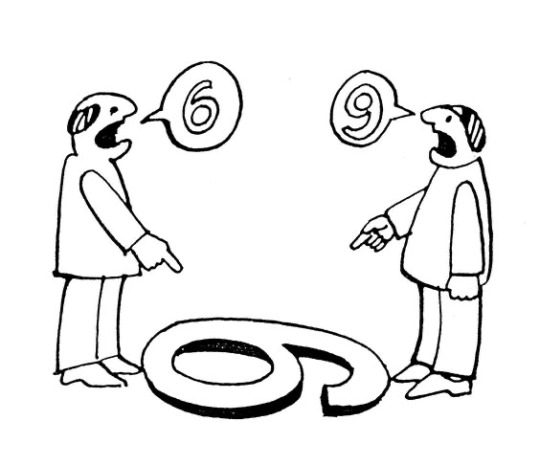


In the Week 10 lesson on poststructuralism, I realised the importance of penetrating beyond surface meaning in design practice and analysing the underlying systems and structures that shape design solutions (figure 1).
This was particularly evident during our group work in which we paired up text and images created without prior consultation. In the process, it became apparent that any text or phenomenon can be interpreted differently depending on one's point of view (figure 2). In connecting our pictures, which at first glance were not connected, we discovered a multiplicity of perspectives and interpretations based on our life experiences and visualisations of different processes.
Poststructuralism opens the door to a world where there are no absolutes. The world becomes a space for dialogue and discussion rather than the acceptance of unambiguous truths. In my opinion, this is where the complexity and multifaceted nature of the human world lies. This approach made me think, analyse and, most importantly, learn to see the world through the eyes of others.
I think it is especially important for a designer to see the world through the eyes of the user, because design is first and foremost created for people. We, as professionals, need to understand and analyse their world and thinking in order for our design solution to be effective.
For example, in my work, I do a lot of analyses both with customers and various tests and interviews with users. By bringing together the world of the business leaders and the world of the user, I can build an effective connection where everyone benefits in the end (figure 3).
262 words (275 max)
References:
Artresting publishing. “Dali & Picasso; A comparison”. Svetlana, 2013. https://artresting.wordpress.com/2013/11/17/dali-picasso-a-comparison/ Accessed 14 March 2024
#open minded#poststructualism#individual meaning and values#mindfulness benefits#an emphasis on language and discourse#think creatively#think differently
0 notes
Text
Analytical Application 3
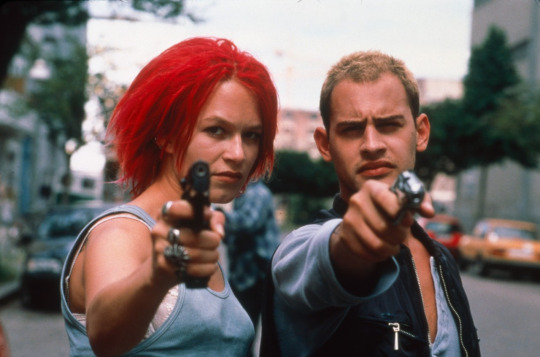
Through the workings of Frederic Jameson in “Postmodernism and Consumer Society,” parody is the replication and immigration of other film styles and mannerisms that are intended to mock the themes and elements of the differentiating works or genres in a comedic manner. Parody “capitalises on the uniqueness of these styles and seizes on their idiosyncrasies and eccentricities to produce an imitation which mocks the original.” (1)
In “Run Lola Run” (1998), the dialogue between Lola and the security guard working at her father’s bank, furthers the engagement of the film with the theory of parody from Fredric Jameson. The vague condescending, “philosophical” tone in which the security guard took on serves as a form of parody while referencing traditional tropes. The setting and the character’s role of the guardians with Lola is a parody of the traditional heist scenarios.
The dialogue of Lola pleading to the guard to let her into the highly secured bank area is reminiscent of classic film tropes where the protagonist urgently tries to explain their situation or negotiate with an authority figure, such as one like the security guard. “Courtesy and composure are queen’s jewels” (00:39:13) is a direct line from the security, underscoring how the importances of grace and dignity contributes to the theme of regality. In the context of a heist scene, this vague dialogue coming directly from the “authority figure” aligns with Jameson’s idea of how parody is a form of playful imitation that does not induce a deeper critical analysis. The quote from the guard does provide humor for the audience, as we know the dire situation at hand for Lola, but it does not mock the classic heist film scenarios rather it recycles, remixes, and integrates the form for the audience’s enjoyment.
By the definition of Frederic Jameson in his work “Postmodernism and Consumer Society,” pastiche “involve the imitation or, better still, the mimicry of other styles and particularly of the mannerisms and stylistic twitches of other styles.”(2) In comparison to his idea of parody, pastiche is more of a emulation of these past films or filmmaking techniques to pay homage to. There is no hint of mockery or satire, the intention of pastiche is to celebrate the qualities of different styles.
Instead of a specific scene to highlight in “Run Lola Run” (1998), the soundtrack, composed by Tom Tykwer, plays a significant role in the demonstration of pastiche. The soundtrack is a blend of a multitude of different genres, including techno, electronic, experimental, and even the incorporation of jazz. The technique of pastiche involves the usage of repetition within the film; the techno beats and electronic sound with that lulling bass reappears throughout the film which directly aligns with Jameson’s idea of parody and Delueze’s thoughts on generality–the reusing of different elements that creates a sense of deja vu for the audience. In a ton of underground experimental films and short films, the use of techno music can be found easily within the scene. As well, the electronic music found within “Run Lola Run” also reflects the sound that is associated with the 90s especially in Germany. During the 80s, the genre of German techno boomed within the contemporary culture of that time. The sounds of the genre is characterized by its repetitive nature and simplistic style and melody to create a futuristic soundscape, which is highlighted throughout the film. The Berlin Club scene is notorious for its German techno, the use of these sounds contributes to the film’s pastiche as it mimics the techniques of other experimental films while building upon the thriller aspect of the film. Lastly, to my surprise the film used “What a Difference a Day Makes' ', a classic jazz song; this eclectic usage of different genres reflects the postmodern techniques of mixing different genres without adhering to the traditional form of musical genres and periods.
In “Difference and Repetition", Deleuze states “[T]he repetition of a work of art is like a singularity without concept.”(3) Meaning that repetition is not merely the mimicry or reiteration of events, but rather when a work of art undergoes the process of repetition with creativity in mind, a variation is produced that is now unique and singular.
In the film, “Run Lola Run” (1998), the entirety of the plot is subject to the repetition of Lola running to Manni while attempting to solve the issue of the lost 100,000 marks. In each variation, Lola encounters a thief on a bike. The first time, she barely interacts with the man resulting in the snapshots of him getting beaten to a pulp before meeting his future wife (00:15:58). The second time around, Lola apprehends him and confronts him for stealing which ends up depicting his life as a junkie (00:37:34). And the last time, she completely avoids interacting with him–forcing him to take a different route. Each time this timeline repeats itself, Lola encounters the bike thief in a slightly different manner which breaks the deterministic narrative structure. Each run-in results in a distinctly different outcome for the man’s future, which lends itself to Deleuze’s ideas of repetition, it is not just a reproduction of the same scene but possibility of the creation of something brand new. Lola’s decisions during her encounters with the man becomes a pivotal moment where it alters the trajectory of the final narrative with Manni, highlighting the idea that repetition generates possibilities and creativity instead of constraining the overall plot. The varied responses being produced by Lola and the man on the bike demonstrates the film’s exploration of Deleuze’s theory on repetition.
Through the working of Deleuze’s “Difference and Repetition,” he explains that “generality expresses a point of view according to which one term may be exchanged or substituted for another.” (4) Meaning that the application of generality is an attempt to encompass ideas or ways of thinking to share commonalities to establish an ideal that can be applied to everyone, creating a universal experience.
Key scenes to apply Deleuze’s theory of generality are Lola's encounters with the minor characters during her three trials of attempting to save Manni in “Run Lola Run” (1998). In the context of Deleuze’s ideologies, the generality behind these scenes challenges conventional notions of determinism. The repeated scenarios of running into the older woman with the baby carriage suggests the universal themes of motherhood are not contingent from the fixed concepts and representations of parenting. Rather, the snapshots of the mother losing her biological child and then kidnapping a baby in a stroller (00:13:01-00:13:18) versus the other portrayals of the older woman winning the lottery (00:36:18-00:36:32) emphasizes how the idea of unity emerges from events that unfold in each encounter. The woman with the stroller is often associated with themes of nurture and protection, however through the different variations, as a representation of motherhood, she becomes a gateway for the audience to unmask the diverse ways in which a situated role can intersect with different elements (Lola) which build upon the narrative.
The characters in which Lola’s actions and decisions lend themselves to the different outcomes and possibilities based on her small variations emphasizes Deleuze’s ideas of generality. Applying this knowledge to the analysis of these scenes, these moments capture how the film represents a universal and relatable experience (generality) through the complexities and differences within the narrative structure. The possibilities that can derive from Lola’s chaotic run to Manni directly plays a role into the theory of generality.
Through the work of Jean Baudrillard in “Simulacra and Simulations,” hyperreality is the state in which reality and the simulate amalgamate to create a surreal experience. Baudrillard suggests that the lack of distinction between what is real and what is simulated are shaped by contemporary media, that in a hyperreal state, signs and symbols cloud a viewer's intake and interpretation. Baudrillard states “Thus the hyperrealism of simulation is expressed everywhere by the real's striking resemblance to itself.” (5)
A scene within the film “Run Lola Run” (1998) that depicts a hyperreal society that can be seen between the romantic interactions between Lola’s father and his mistress (00:17:53). Desires are often misconstructed by the media and are also mediated through consumer-driven culture; the scenes are a performance that is influenced by media portrayals of love and desire. In the first variation of Lola’s run, the scenes between her father and the woman have this light lighting and slight haziness that cloud the screen–emulating the illusion of pure love. The aesthetics of these scenes employ certain visual elements that are associated with the cliches of romance; on that same note, these aesthetics do incorporate the simulated versions of romantic relationships that contribute to the hyperreal representation that do not encompass the authenticity and the individualistic experience of love and romance. The influence of consumer culture is apparent in the format in which the scenes are shot. The soft and gentle gestures between Lola’s father and the woman he is having an affair with is an aesthetic that is commonly found in romantic relationships that are displayed all over the media. It is this creation of a simulation that is seemingly more real than personalized experiences that transports the audience into a hyperreal realm. These scenes represent a commodified version of romance, where these “romantic” gazes lose its genuine nature thus becoming a set of consumable symbols that are easier for the viewer to digest when indulging the film’s narrative.
Fredric Jameson, “Postmodernism and Consumer Society” in Modernism/Postmodernism (New York: Pearson Education Unlimited, 1992), 166.
Fredric Jameson, “Postmodernism and Consumer Society” in Modernism/Postmodernism (New York: Pearson Education Unlimited, 1992), 166.
Gilles Deleuze. Difference and Repetition (New York, New York: Columbia University Press, 1994), 15.
Gilles Deleuze. Difference and Repetition (New York, New York: Columbia University Press, 1994), 15.
Jean Baudrillard, “Simulacra and Simulations” in Modernism/Postmodernism (New York: Pearson Education Unlimited, 1992), 152-153.
0 notes
Text
Analytical Application 3
Parody
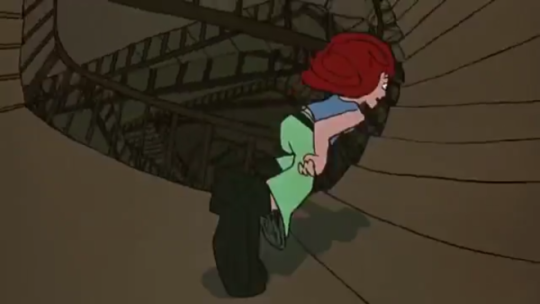
In Fredric Jameson’s “'Postmodernism and Consumer Society”, he introduces the concept of parody, and how it relates to his overarching ideas about postmodernism and consumerism. To him, parody relates heavily to one of the key components of postmodernism: pastiche. To Jameson, “Both pastiche and parody involve the imitation or, better still, the mimicry of other styles and particularly of the mannerisms and stylistic twitches of other styles” (Jameson, 166). In his eyes, parody does this with the intention of humor. For Jameson, “the general effect of parody is - whether in sympathy or with malice - to cast ridicule on the private nature of these stylistic mannerisms and their excessiveness and eccentricity with respect to the way people normally speak or write” (Jameson, 166). The film Lola Rennt, known in English as Run Lola Run, contains three different time loops. In each of them, we see our two protagonists, Lola and Manni, go around their unnamed German city, which I will be referring to as Berlin, as that is where the film was shot, encountering many locations in different ways as they go through their episodes. One such location is the staircase that Lola runs down as she sets off on her journey at the beginning of each of these time loops. This staircase is hardly filmed, opting rather to be shown in a hyper-stylized animated style. We are introduced to this animation style during the opening credits. The first time loop, which I will be calling “the original”, shows Lola running down the stairs, then a close up of her face, then she screams, and then we see a man and his dog, who growls at Lola, frightening her. She runs past, and leaves the building no problem. The second loop is where parody is introduced. The second loop comes at the time when we understand the structure of the film: time loops. Thus, we believe that the second loop will be the same as the original. This is not the case, as becomes apparent once Lola is tripped down the stairs by the young man with the dog. We see the man and the dog for much longer than in the original, and we zoom in on the man giving a sneaky grin. His braces sparkle and he laughs a cartoonishly smug giggle. When he trips Lola, she screams and falls down the stairs. These elements, coupled with the simple, perhaps goofy-looking art style, lend heavily to the comedy of the moment. The second staircase scene is, thus, a parody of the original. It maintains the style of the original, but the content is far more humorous.
Pastiche
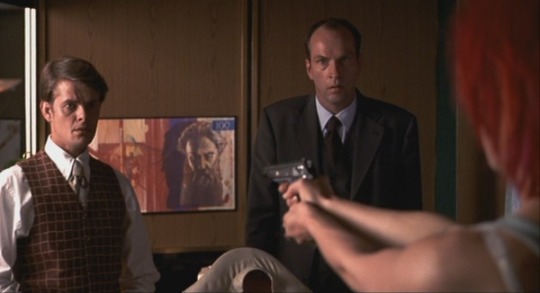
In Fredric Jameson’s “'Postmodernism and Consumer Society”, he introduces the concept of pastiche, and how it relates to his overarching ideas about postmodernism and consumerism. To him, pastiche is a key component of postmodernism. “Both pastiche and parody involve the imitation or, better still, the mimicry of other styles and particularly of the mannerisms and stylistic twitches of other styles” (Jameson, 166). However, pastiche, as Jameson says, “is blank parody, parody that has lost its sense of humor…” (Jameson, 167). In short, pastiche reproduces, without offering mimicry or malice towards the thing it is reproducing. The film Run Lola Run contains three different time loops. In each of them, we see our two protagonists, Lola and Manni, go around Berlin, encountering many locations in different ways as they go through their episodes. One such location that I believe exemplifies the idea of pastiche is the bank where Lola’s father works. In the original time loop, we learn that Lola’s father has had an affair, and is planning on running away with the woman. When Lola comes to ask him for money, he escorts her out of the building, calling her a weirdo. In the second time loop, Lola enters on her father and his mistress having an argument. The mistress is pregnant by another man. When Lola enters the room, she seemingly remembers the events of the original time loop, and thus, she lashes out at the mistress. Her father slaps her. Lola runs out, grabs the security guard’s gun, and holds the entire bank up until she gets her money. It takes no genius to know that this scene could have been hilarious. All the elements of parody are present. It is the saddest version of the original loop, and that could be played as a humorous thing. Instead, the film opts to play the scene as seriously as possible. The music, while pulsing, is quiet. The actors perform their roles in a way that isn’t over acting, and isn’t under acting. The reality of the scene is highlighted, making it all the more serious. As mentioned above, pastiche is when something is reproduced without offering mimicry or malice towards the thing it is reproducing. This scene does exactly that. There are no silly expressions on the screen or goofy callbacks. The scene is what it is, and what it is is serious.
Simulacrum

In Jean Baudrillard’s “Simulacra and Simulations”, he outlines his ideas on what would become a key postmodernist theory, the idea of simulacra. Simulacra, to Baudrillard, refer to copies or representations of reality that have lost their connection to the original reality they are trying to represent. This happens through a process of four steps. One, an item becomes a reflection of reality. Two, an item masks and perverts basic reality. Three, an item masks the absence of basic reality. And finally, an item bears no resemblance to reality whatsoever, becoming simulacra (Baudrillard, 152-153). This film, Run Lola Run, as a whole is one that embodies the spirit of simulacra very well. The time loops offer a very interesting case to be analyzed in the eyes of simulacra. In particular, the casino near the end of the film is a great framing for simulacra. In the final time loop, Lola runs through the streets of Berlin, this time with everything slightly different from the first two. She is unable to reach her father by the time he leaves his bank, so she runs to the casino to try to win 100,000 marks with just one 100 mark chip. Let’s think of the first time loop as “reality”, though the other two are framed as being as real as the first. Truthfully, we don’t know if the other two are real. Perhaps these are the dying thoughts of Lola. Regardless, if we take the first time loop as “reality”, then we have already achieved step one by just being in this situation. The time loop is a reflection of Lola’s reality. We have also achieved the second step. Through the slightly different second time loop, basic reality has been masked and perverted, though still seeming to be a reflection of basic reality. And we now find ourselves absent from basic reality, being masked by the very time loops that created this absence. Being in the third time loop, we are convinced that we are in a state of basic reality, for that is what we now know to be true. But this is not reality. This is something else completely. And so here we are. In front of the casino, a brand new location. This new space bears no resemblance to any reality we’ve encountered before, therefore becoming in itself a simulacra.
Postmodernism
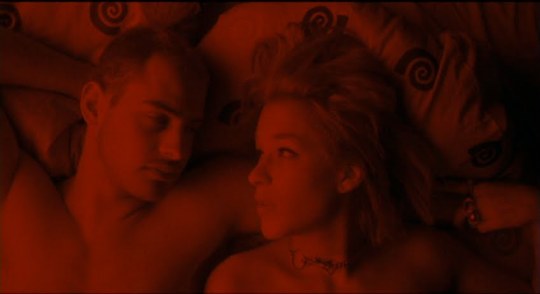
Postmodernism is a concept introduced by Fredric Jameson in his piece “'Postmodernism and Consumer Society”. He does not give a clear definition, but it can be described as a movement of creative and stylistic advancements and changes across a multitude of genres and mediums that push against high modernism, the style that existed beforehand. It is also a new way of cultural and economic thinking. Postmodernism pushes against consumerism and instead promotes free thought. The film Run Lola Run operates in a space that is greatly influenced by postmodernist ideals and virtues. I will start with the scene at the end of the first time loop, in which Lola is shot, and she sees herself and Manni having a discussion in bed. A key postmodernist idea is the rejection of objectivity, and the embrace of self-referentiality. As we see in this scene, and very soon after, Run Lola Run is the epitome of these ideas. In her dying moments Lola looks into herself, not to what she may perceive as reality, that being that she is shot and will die. In her conversation with Manni, which may or may not have happened, she comes to realize that she does not wish to die in this way. So, she doesn’t. The film, as we then see, develops a time loop. By ignoring reality and objectivity, Lola acquires a power to relive the 20 minutes, by sheer will. We can also see this postmodernist thought through the animation style used during Run Lola Run’s opening credits and staircase sequences. Jameson outlines that modernist artists are being pushed out in favor of postmodernists by the younger generation (Jameson, 164). It would seem that this animation is a part of this movement, disregarding the maximalist styles of artists like Picasso and Pollock, and opting for a more simplistic, rough approach that matches the rugged nature of the rest of the film. The stylistic and narrative choices made by the creators of this film greatly enhance the postmodernist view of the film.
Simulation
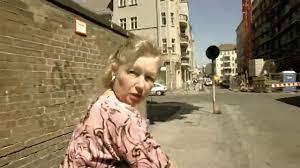
In his piece “Simulacra and Simulations”, Jean Baudilard introduces his concept of simulation. Simulation is to Baudrillard a key idea of postmodernist thought, in which representations and signs take on a life of their own, becoming detached from any reality that previously existed. He gives that example of Disneyland as a space that exists in our modern world that is a simulation. “The Disneyland imaginary is neither true nor false: it is a deterrence machine set up in order to rejuvenate in reverse the fiction of the real. ” (Baudrillard, 154). To analyze simulations in the film Run Lola Run, let's take a look at one of the many side characters in the film, the woman with the stroller who Lola passes first on her journey to Manni. We see her in all three time loops. First, we see that after Lola bumps into her the government comes to take her child away, and she ends up taking another child from a temporarily unsupervised stroller in the park. Next, we see her win the lottery after Lola bumps her. And finally, after Lola avoids her, we see her join the sisterhood and become a nun. Let’s think of this woman as a sign. She and the rest of the side characters who we are shown the futures of are representations of the butterfly effect and determinism. However, she becomes, or perhaps represents a simulation during the final time loop, in which Lola avoids her entirely. After Lola passes her, we are still shown a flash forward, in which she becomes a nun. This can be seen as her, the sign, taking on a life of her own. Her actions are neither positive nor negative, being presented in a rather neutral manner. She has lost contact with what she was before, which is a largely positive or negative reality. She has entered the simulation of neutrality. We see this with the other side characters as well. The biker gives the bike away to a homeless man, the driver doesn’t crash his car (or at least doesn’t get beat up), and the woman in the bank, who previously was married or killed herself, is not shown with anything. These people, by avoiding Lola, have become simulations.
Works Cited
Jameson, Frederic. “Frederic Jameson, ‘Postmodernism and Consumer Society’.’” Essay. In Modernism/Postmodernism, 166. New York, New York: Routledge, 2014.
Jameson, Frederic. “Frederic Jameson, ‘Postmodernism and Consumer Society’.’” Essay. In Modernism/Postmodernism, 167. New York, New York: Routledge, 2014.
Baudrillard, Jean. “Jean Baudrillard, from ‘Simulacra and Simulations.’” Essay. In Modernism/Postmodernism, 152-153. New York, New York: Routledge, 2014.
Jameson, Frederic. “Frederic Jameson, ‘Postmodernism and Consumer Society’.’” Essay. In Modernism/Postmodernism, 164. New York, New York: Routledge, 2014.
Baudrillard, Jean. “Jean Baudrillard, from ‘Simulacra and Simulations.’” Essay. In Modernism/Postmodernism, 154. New York, New York: Routledge, 2014.
Run Lola Run. Directed by Tom Tykwer. Sony Pictures Classics, . https://video.alexanderstreet.com/watch/run-lola-run.
0 notes
Text
Analytical Application 3
Generality:

Generality can be partially defined by being the opposite of repetition. That is, it is both the “qualitative order of resemblances” and the “quantitative order of equivalences.”[1] Where repetition injects a creative twist to its variations, generality mandates that things are placed into similar categories such that they can be universally defined by the same label. In Run, Lola, Run, generality can be found in certain scenes where photographs are used to examine the futures of those that interact with the protagonist, Lola. Several characters experience this over the course of the film, but for analytical purposes we will look at the young male character with the bike. His first iteration of photographs displays him getting mugged, finding a girl when he goes to get patched up, then his marriage to said girl (Tykwer, 1998, 15:56-16:03). Though these photographs portray the character’s individual experience, the fact that it is shown in the film clues the viewer in to the fictionality of the story, and therefore they are able to identify the tropes displayed through short synopsis of the character’s life events. A trope is a manifestation of generality, as tropes are repeated and reused in stories worldwide. They are so recognizable in concept that small elements are able to change within them, yet they can still be lumped into the same category. A ‘miscommunication’ trope is still miscommunication whether the characters think the other cheated or is on the brink of death. Small changes still evoke the general recognition of the trope in the viewer. Though creativity in repeating these tropes can breath new life into them, the short snapshots of the character’s future rely on recognizable ‘plot points’ within these tropes so that the viewer can pick up the story in only five or six photographs. Therefore, the repetition points more towards resemblance than repetition.
Postmodern:

The postmodern is a “negation of the previous epoch,” which in this case is modernism.[2] Jameson also asserts that postmodernism aims to appeal to the masses, which opposes the individual expression of the modernist era.[3] In order to achieve both of these ideals, postmodernism draws on nostalgia and the pastiche to create recognizable images that the audience will love upon first sight. In Run, Lola, Run, this postmodern effect comes in the form of the scene bathed in red post Manni’s death. This scene is a repetition of the one from when Lola herself died. The main characters are lying next to each other in bed, washed in red lighting, smoking and pondering love and death (Tykwer, 1998, 52:29-54:40). Because this scene comes later in the movie, after we have already seen its predecessor, the audience is able to recognize the scene right away from its coloring and the framing of the actors. Even though the audience saw the other version only twenty minutes prior, there is already a sort of nostalgia for it, a longing to go back to the past. Since this scene comes after the death of Manni, the audience has only to wonder if Lola will be able to save both of them the third time around. The scene has a postmodern feel to it because of this nostalgic appeal as well as its immediate recognizability to those who have seen the prior scene in the movie that is similar to it.
Repetition:
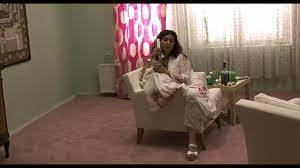
Repetition, as described by Deleuze, is a “transgression.”[4] It functions by creatively putting out variations, which favors an artistic reality rather than that which follows the natural law. Repetition does not belong with generality, though Deleuze does admit that repetition may be appropriate when you cannot replace something with that of equal value (a resemblance). In Run, Lola, Run, the first major repetition is exemplified when Lola seemingly travels back in time and relives the past twenty minutes again (Tykwer, 1998, 34:26-35:42). During the repetition, some things stay the same, such as Lola’s mom asking her to buy shampoo (funnily enough, this never changes during any of the repetitions during the film) and Lola running down the stairs. The first ripple of creativity that this repetition utilizes is when Lola runs past the guy with the dog. Unlike the first iteration where she just runs past them both, the guy trips Lola so she falls down the stairs. Though it is a cruel moment, it shows the audience that this time, things are going to be different, which not only keeps them engaged, but furthers the idea that repetitions are favored in an artistic reality.
Simulation:
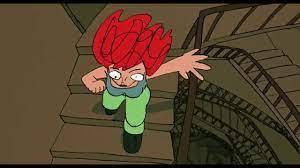
A simulation is formed at the fourth phase of an image. Baudrillard explains the phases of the image as such: it reflects reality; it masks or perverts reality; it masks the absence of reality; it no longer relates to reality.[5] By the fourth phase, the image is its own simulacrum, or part of a simulation. The simulation aims to conjure up the idea of reality without really being there. It tries to deter those within the simulation from ever comparing it to reality and trying to leave it. When Baudrillard compares Disneyland to a simulation, he is not far off; the theme park tries to create an imaginary reality so enticing you’ll forget that you have to leave.[6] In Run, Lola, Run, there is a scene where the camera pans from Lola to her mother in a separate room, then to an animated version of Lola running down the stairs (that plays on the TV in her mother’s room), then cutting abruptly back to reality when Lola opens the door (Tykwer, 1998, 11:45-12:40). The animated section can be designated as the simulation and the live action part as the reality. The animated section as the simulation works as it feels like a world within a world, as Lola running downstairs plays on the TV while also definitely happening in real life. The blending of these two, making them inextricably linked, forges a bond between the simulation and the reality that makes it hard to separate them. The animated world might seem more ideal since there seem to be less repercussions than in the real world. The interesting part about this simulation is that it does, in fact, relate to reality. The audience assumes that because animated-Lola is running down the stairs, real-Lola is too. By linking the animated world to the real world—the simulation to the reality—the director is able to streamline the storytelling.
Pastiche:
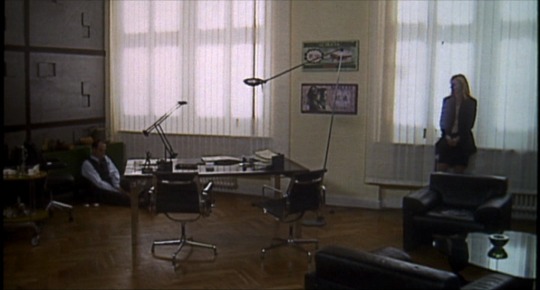
Jameson defines pastiche as such: “parody without the humor.”[7] Where a parody uses satirical devices to repeat and retell, a pastiche imitates the original work, using its style to create something new. Though a pastiche may be created in good faith, it often does not add anything to the original work. Paying homage to the original work is all well and good, but it is only a reproduction of an artwork that has already been tried and tested. This new work has nothing to say about the old one other than that it was inspirational. There is such a scene in Run, Lola, Run. Before Lola enters her father’s office, there is a short scene where her father speaks with the woman from the board of directors. It is all very dramatic; she tells him she’s pregnant, he says he’ll leave his wife for her, all that jazz. The scene, notably, is heavily filtered to have this old TV grain effect. It conjures up images of dramatic soap operas and TV shows where the protagonists are in love but can’t be, where they must go against all odds to be with each other. The grain is a nice shortcut to get the audience invested in that subplot quickly just by mere association, but the interesting part is when Lola enters, this grain immediately vanishes. Clearly, the grain is only meant for when those two characters are together talking about their love. This is a pastiche, an imitation of the old without bringing saying anything about it. Even in the consequent repetitions of the scene later in the film, the grain remains while the story fluctuates through different dramatic beats of a TV soap opera. The pastiche takes the remake of this drama seriously, without even a drop of humor to identify it as a parody. This choice makes it easier for the audience to get invested in the story of these characters, but the grain going away when Lola enters clues the viewer back in to the real story.
[1] Deleuze
[2] Jameson
[3] Jameson
[4] Deleuze
[5] Baudrillard
[6] Baudrillard
[7] Jameson
@theuncannyprofessoro
0 notes
Text
Analytical Application 3: Poststructuralism and Postmodernism
Repetition
Definition:
In Difference and Repetition, Deleuze explains that “repetition is attributed to elements which are really distinct but nevertheless share strictly the same concept,” (1). Repetition can be described as the reiteration of events, ideas, or forms in a way that produces variation of the original object in a novel way.

Analysis:
In "Run Lola Run" (1998), the plot revolves around instances of repetition with Lola repeating the same journey to retrieve 100,000 marks three times with minor differences altering the overall outcome. As a result, there are multiple examples of repeated actions leading to different outcomes, but one example that stands out is Lola’s interaction with the young man who offers her his bike for 50 marks, (Tykwer, 1998, 15:49). Each time the timeline of the story repeats, she has the same repeated interaction with the man but with subtle, notable differences. The way their interaction unfolds also ends up affecting the rest of the young man’s life path, with the minor differences in each interaction eventually leading to vastly different outcomes. When first encountering the man, Lola refuses his offer. This leads to an intercut compilation of photos of the man’s future where he is intercepted by two men and beat up before meeting his future wife (Tykwer, 1998, 15:58). During the second instance of Lola’s encounter, however, she points out that the bike the man is riding is stolen, (Tykwer, 1998, 37:39). Afterwards, the intercut photos show that the man leads the rest of his life on the streets, a stark contrast to the first outcome (Tykwer, 1998, 37:44). This example perfectly encapsulates Deleuze’s definition of repetition. Although Lola has multiple run-ins with the man on the bike, each instance has novel differences that lead to different paths in the end, building upon the original instance of the interaction. Not only is the interaction reproduced in a novel way; the after-effects also echo the same originality.
Generality
Definition:
In the Introduction of Deleuze’s Difference and Repetition, he explains that “[g]enerality presents… the qualitative order of resemblances and the quantitative order of equivalences. Cycles and equalities are their respective symbols. But in any case, generality expresses a point of view according to which one term may be exchanged or substituted for another,” (2). In simple terms, "generality" can be understood in two main ways: by looking at how things are visually similar to each other and by looking at how things are equal or equivalent to each other. This generality then can lead to the exchange or substitution of the two things being compared, creating a universal or relatable experience.
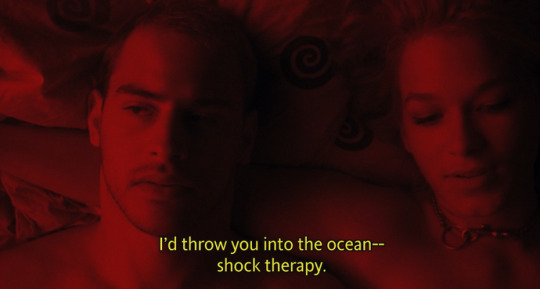
Analysis:
Deleuze’s theory of generality can be applied to the scene of Manni and Lola smoking in bed together (Tykwer, 1998, 52:32) in "Run Lola Run" (1998). Throughout the entirety of the film, Lola's primary objective is to save Manni from a dire situation, which adds depth to their relationship. In this particular scene, as Manni and Lola lay together in bed, engaging in a conversation about Manni's hypothetical death, the audience gains insight into the complexities of their relationship. This scene serves as a poignant portrayal of love and loss, further establishing a sense of generality within the audience. By witnessing the intimate exchange between Manni and Lola, viewers are offered a glimpse into their emotional bond, allowing for a more relatable or generalized understanding of Lola's motivations and actions throughout the film. The scene provides context to Lola's unwavering determination to save Manni, as her love for him is palpable in their shared moments of vulnerability and reflection. The use of red lighting in the scene also enhances the emotional resonance, evoking feelings of passion and intensity associated with love. This visual element reinforces the audience's connection to the characters' relationship, relating the color's associations with the generalized idea of their love for each other. In essence, Deleuze's theory of generality is exemplified in this scene through the portrayal of universal themes of love and loss, as well as through the relatable dynamics of Manni and Lola's relationship. A hypothetical conversation like this one is common in most relationships. Through their intimate exchange and the use of visual symbolism, the scene creates a shared emotional experience that resonates with the audience, further emphasizing the generality between the audience and characters.
Order of Simulcra
Definition:
In a passage from Baudrillard’s “Simulacra and Simulations,” the Order of Simulacra can be linked to the four successive phases of the image. These phases are written as:
“(1) It is the reflection of a basic reality.
(2) It masks and perverts a basic reality.
(3) It masks the absence of a basic reality.
(4) It bears no relation to any reality whatever: it is its own pure simulacrum,” (3).
This order represents the progression of the relationship between reality and its representations as it becomes a pure simulation (or simulacrum) with no reference to reality.

Analysis:
One can apply the Order of Simulacra and its four successive phases of the image to “Run Lola Run” (1998) during the casino scene toward the end of the film (Tykwer, 1998, 1:05:19). During this scene, Lola heads to the casino at a loss for any other way to get the money to save Manni. Previously throughout the film, we have seen evidence that Lola has supernatural abilities to manipulate time and space, but this scene culminates all of this evidence at once. Firstly, the casino is a reflection of a basic reality by reflecting a familiar instance of a casino; typical games and casino attendees are present. However, this reality is masked and perverted when the attendees and staff interact with Lola. She stands out by not being in dress code, and further marks herself by winning roulette 3.5:1 on a whim. A staff member tries to intervene with Lola’s success by whispering to her, “Come with me please,” (Tykwer, 1998, 1:07:02), but Lola refuses. This moment marks the perversion and danger of this evil reality, with attendees and casino staff around her seemingly being against her success combined with her visible status. The image also reaches the third stage, masking the absence of a basic reality with Lola winning and then betting on the same number yet again. Finally, the fourth stage is reached as Lola screams at the top of her lungs to presumably affect the roulette results, breaking various glasses (and guests’ eardrums) in the process. This manipulation succeeds in her winning yet again, bearing no relation to reality and becoming its own simulacrum of a casino experience.
Simulation
Definition:
Simulation refers to the process of creating a model or imitation of a real-world system or phenomenon. Baudrillard associates the term with “a false representation of reality,” (4) which is hyperrealistic in some way. The simulation can be associated with each successive phase of the image as a representation of reality.
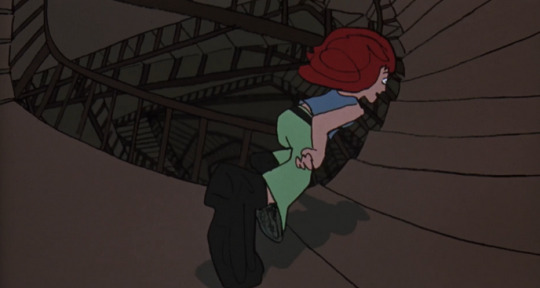
Analysis:
The most obvious scene from “Run Lola Run” (1998) that can be associated with Baudrillard’s definition of simulation is the repeated animation scene of Lola running down the stairs from her apartment (Tykwer, 1998, 12:15). This scene has multiple factors which make it hyperrealistic in one way or another. Firstly, as the scene transitions from the last, the animated sequence is shown through the television in Lola’s living room where her mother sits. This crosses a hyperrealistic border of a simulation. This blending of animated and live-action footage contributes to the sense of hyperreality by presenting an alternate reality within the film’s narrative framework. Secondly, the animated sequence shows the stairs as infinite. As Lola runs down them, there are countless staircases spiraling in the background. Despite the fact that these stairs never seem to end, Lola reaches the bottom after encountering a man and his dog. This shows a clear instance of hyperrealism, presenting a distorted version of reality. Finally, the use of animation in this scene serves as a final detachment from reality, allowing the viewer to create a new image of reality based on the film’s establishment of continuity. Overall, the repeated animation sequence of Lola running down the stairs in “Run Lola Run'' (1998) exemplifies Baudrillard’s concept of simulation by presenting a hyperrealistic depiction of space and movement that blurs the boundary between reality and representation.
Parody
Definition:
Parody refers to the imitating or mimicking a particular style, work, genre, or scenario with deliberate exaggeration or distortion for comedic or critical effect. James particularly highlights that “the general effect of parody is… to cast ridicule on the private nature of these stylistic mannerisms and their excessiveness…” (5), emphasizing the intended mockery or satire of the subject of the parody.
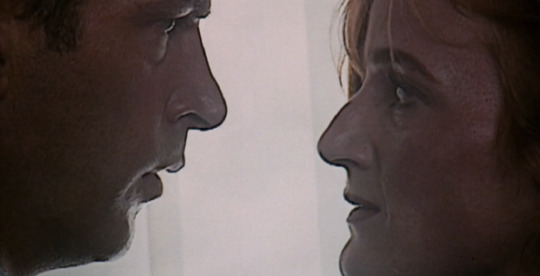
Analysis:
A scene in "Run Lola Run" (1998) that aligns with Jameson's lens of parody is the confrontation between Lola's father and his mistress during Lola's second run (Tykwer, 1998, 38:55). This scene introduces a layer of parody through its exaggerated portrayal of familial drama and the distortion of traditional narrative expectations. During Lola’s first attempt to obtain 100,000 marks, she learns that she is not her father’s child when she meets with him and asks him for the money. In this scene where Lola’s father and his mistress are discussing that she is pregnant, she mentions that the baby could belong to someone other than him, leading them to have a loud fight in Lola’s father’s office. The introduction of this layer of dramatic irony further enhances the parody within the scene. Viewers are aware of Lola's father's previous involvement in potentially raising a child who is not his own, adding a satirical twist to the unfolding events. Much of the serious tone of this film’s scenes, including this one, emphasize the excessive nature of certain reactions. Lola then walks in on this interaction, adding to the absurdity of the situation as well as the dramatic irony. When considered alongside the repetition of this scene throughout the film, it becomes apparent that this moment serves as a parody of familial dysfunction and the complexities of human relationships. Through its exaggerated portrayal and distortion of traditional narrative tropes, this scene highlights Jameson's notion of parody as a tool for casting ridicule on exaggerated stylistic mannerisms and excesses within the film's narrative.
(1) Gilles Deleuze. Difference and Repetition (New York, New York: Columbia University Press, 1994), 15.
(2) Deleuze, Difference and Repetition, 1.
(3) Jean Baudrillard, “Simulacra and Simulations” in Modernism/Postmodernism (New York: Pearson Education Unlimited, 1992), 152-153.
(4) Baudrillard, “Simulacra and Simulations”, 154.
(5) Fredric Jameson, “Postmodernism and Consumer Society” in Modernism/Postmodernism (New York: Pearson Education Unlimited, 1992), 166.
0 notes
Text
Lola Rennt Analytical Application
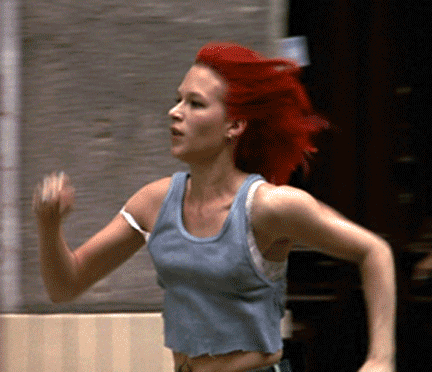
Difference is explained by French philosopher Giles Deleuze as a fundamental concept that drives creativity and diversity in projects. In the film world, one could understand “difference” as something that sets a film apart from something else. In Deleuze’s Difference and Repetition, he writes about variation: “a law compels its subjects to illustrate it only at the cost of their own change” (1). Variation in creation drives change and difference is a way of expecting change in what we consume. Lola Rennt (1998) employs difference by utilizing mixed media and a creative narrative structure in its filmmaking. Immediately into the film, filmmaker Tom Tykwer creates a creative world by incorporating mixed media elements and special effects. For example, in one of the beginning scenes after main character Lola has received the call from Manni, she immediately starts to think of people and places where she can get the money. Photos of these people start to flash before the audience, mimicking Lola’s quick thoughts of people she can go to (2). These quick photographs and the integration of animation and photography in the film is an example of difference because it is a use of creativity and diverse uses of art and storytelling that sets the film apart from the norms consumers have seen before. Specifically, the film’s “quirkiness,” or the unpredictable nature of the narrative, the character, and the cinematography fall into Deleuze’s idea of difference because it makes an effort to set itself apart from things the audiences can recognize and relate to.

Postmodernism is explained by Fredric Jameson, who suggests that there isn't one fixed truth, but instead, many different perspectives and ways of looking at things. Postmodernism could be seeing the world as a mix of different stories rather than one big, clear picture. He writes: “Postmodernisms is the effacement in it of some key boundaries or separations, most notably the erosion of the older distinction between high culture and so-called mass or popular culture” (3). He goes on to explain that postmodernism could mean the emergence of a new social order, defying the expectations of popular culture. In Lola Rennt (1998), the appearance of varied storylines is an example of postmodernism in film. The story structure is distinct from other action films, as well as the twenty-minute time frame that the action must take place in, then repeated three times throughout the film. A scene that is an example of a “postmodern” choice that Tykwer made was the reappearance of the storylines of characters. Lola runs into a man on a bike, and when she declines his offer to buy his bike, it shows his future of what happened because of Lola’s choice (4). The whole plot of Lola’s choices affecting each character and illustrating other characters’ lives because of her decisions or the “domino effect” that occurs during the film is a way that Tykwer utilizes different perspectives and ways of looking at the same problem. Every person in the city has a goal but audiences don’t necessarily see them until Lola clashes with them in one way or another. Postmodernism plays a large role in the entirety of the film’s structure, but it especially stands out when it comes to the futures of the background characters.

Hyperreality refers to when the distinction between what is real and what is simulated or imagined becomes blurred or indistinguishable to the audience. Baudrillard writes: “On the contrary, it is as hyperreal events, no longer having any particular contents or aims, but indefinitely refracted by each other (...) that they are precisely unverifiable by an order which can only exert itself on the real and the rational” (5). Hyperreality is made up of hyperreal events or events that could not realistically happen in reality or easily identifiable as reality but they are presented in a way that makes the events seem rational to the viewer. Lola Rennt (1998) is an entire film that functions in a hyperreality. The effects are eerie and strange, the artistic style transports the audience into a world they are unfamiliar with, and of course, the use of time and being able to go back and make different decisions is something that the audience recognizes as a hyperreal event. For example, when Lola is shot in the first act of the film, has a flashback to a conversation with Manni and then comes back to life is one of the first signs of using an unrealistic to achieve an overall rational story. Lola’s revival (6) goes unexplained and remains a mystery, as well as when Manni dies in the second act and it all happens again. The audience doesn’t know what is real or true to the story anymore, but once it happens, recognizes why Tykwer chose to leave it unexplained. The audience can see Lola make new decisions to help save her and Manni’s lives and make her journey more efficient. While sometimes these new choices are not purposeful, it uses this domino effect again to illustrate how the smallest of changes affects everyone around her. Ultimately, the hyperreal events contribute to the realistic theme of the film.
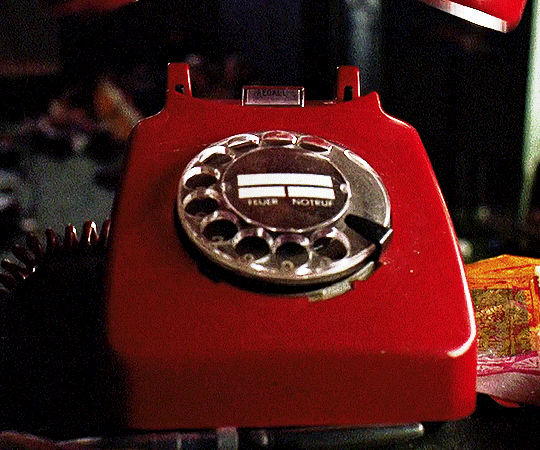
Blockage in postmodern theory signifies various forms of obstruction, constraint, or limitation that disrupts or complicates human experiences, interactions, and endeavors in a fragmented world. There are two types of blockage: artificial blockage, which refers to a “logical limitation,” and natural blockage, which refers to limitation of “a transcendental logic or a dialectic of existence” (7). Blockage is beneficial in cinema because when audience members don’t know everything that will happen, tension arises and the film becomes more complex. As aforementioned, Lola Rennt (1998) utilizes a lot of blockage as audience members don’t understand how Lola can go back in time. Additionally, viewers don’t know Lola’s backstory or any of the characters’ backstories. Blockage is intentionally utilized to unfold the intentions of each character, as some characters’ true colors are revealed quickly while others have a different arc. For example, Lola keeps running into a man driving a car who then crashes into another car, and the audience assumes gets killed by the angry drivers/passengers of the other car. It isn’t until the third act that Lola recognizes the man in the car on her third run (8) as her dad’s coworker. Keeping the audience intentionally blind is a way to build a “plot twist” or shift in plot direction later on. It also helps lead to the eventual death of this character and Lola’s father at the end of the film. Without knowing that this man in the car had to be somewhere the audience would not know the significance of his arrival.

Deleuze explains that repetition is not simply duplication, but a transformative process that allows for the emergence of new possibilities and variations. He writes repetition is “to behave in a certain manner, but in relation to something unique or singular which has no equal or equivalent” (9). The entirety of the plot of Lola Rennt (1998) relies on the concept of repetition – Lola’s journey to get the money literally repeats itself throughout the film, but each journey holds its own meaning and significance. While in the first act, Lola’s father angrily tells her that he’s leaving her family, she misses his presence in the third act (10). This is especially prominent because in the second act, she commits an act of violence against her father by holding a gun against his head (11) and is visibly upset when she realizes how far she has strayed from her original intention of saving Manni (12). With each sequence of repetition, Lola has changed and the overall plot of each act changes with that repetition. The repetition causes something unique in each act that causes a certain sequence of events to occur in the rest of the act.

Deleuze, Giles. “Introduction: Repetition and Difference.” Essay. In Repetition and Difference, (p. 2). New York, NY: Columbia University Press, 1994.
Lola Rennt, 11:14 - 11:45
Jameson, Fredric. “Postmodernism and Consumer Society.” Essay. In Modernism/ Postmodernism, (p. 165). New York, NY: Routledge, 2014.
Lola Rennt, 15:48
Baudrillard, Jean. “Simulacra and Simulations.” Essay. In Modernism/ Postmodernism, (p.157-158) New York, NY: Routledge, 2014.
Lola Rennt, 34:30
Deleuze, Giles. “Introduction: Repetition and Difference.” Essay. In Repetition and Difference, (p. 12). New York, NY: Columbia University Press, 1994.
Lola Rennt, 57:58
Deleuze, Giles. “Introduction: Repetition and Difference.” Essay. In Repetition and Difference, (p. 1). New York, NY: Columbia University Press, 1994.
Lola Rennt, 1:00:00
Lola Rennt, 44:00
Lola Rennt, 47:12
@theuncannyprofessoro
0 notes
Text
I thought I liked poststructualism but these bitches are annoying
2 notes
·
View notes
Text
on the real and the imagined...(1)
The dichotomy of sex and gender and the still prevailing ways in which it works within the contemporary theories of gender are the reflection, or rather, the expression, of another dichotomy that belongs to the family of several grand couples of opposing concepts inherited from the metaphysical tradition. Poststructuralist theories of gender from the last decades of the twentieth century and the beginning of the twenty first perpetuate the classical metaphysical binaries in spite of the consensually shared goal of transcending or doing away with metaphysics altogether. Postmodernism's method of surpassing metaphysical thinking has consisted in the philosophical decision of not tackling what is probably the central classical dichotomy of metaphysics - that between the real and the unreal as the inaccurate mental representation of the real... K. Kolozova (2014) cut of the real...
.... the real is that which is outside interpretation ....
1 note
·
View note
Text
Post-structuralism or something META
The study of literature and interpretive analysis of everything from English poetry to screenplay is a process that is highly subjective by nature. Based on a discussion I had following the English 11 Honors application essay, I talked to some classmates about the poem of that day’s essay and found that because of our backgrounds. We interpreted the same poem, using the same lines as evidence to support what were our own beliefs, which were very opposite. This is a question that has been pondered by students of English through all ages: does literature have a meaning beyond that of the text, and if so at what point does that message become a reflection of the interpreter’s beliefs over the author’s? In a classroom setting, because of the diversity of ideas, religious backgrounds, and otherwise opinions, the undertones are assigned more of an unbiased meaning, taking portions of everyone’s thoughts to create a shared experience and understanding. But what is it an understanding of? The question I find myself wondering is does it properly matter whether the undertones are meant to be interpreted at all and if they are is the purpose to rather than convey the author’s ideas on a subtext level, to share as part of the human experience, a reassertion of one’s own ideals? A lot of terms can be thrown around to attempt to explain such happenings but one I find often is the conformation bias. Humanity is constantly looking for a new tape to measure itself by, in exploring the deeper parts of literature of any kind, there are respected author’s supposed ideas that would approve of one’s actions if that is the way in which it is interpreted. Life is the search for gratification and to be in a position to believe that a renowned and brilliant author would share the same beliefs as the reader or the critique is reassuring for that person. It is interesting to then reflect on earlier this year when Oscar Wilde’s opinion on the levels of literary enlightenment, he argued that the highest level of the literary food chain as based on importance is that of literary critique. Now at this point I’m inclined to agree because it seems as though the true value found for people in literature is that presence of the reassuring affirmation of one’s beliefs, that which is only found in the analysis of the work on a deeper level. Read between the lines. A common phrase, one could say that between the lines is only blank but I would be inclined to say that what one reads between the lines is the sum of their life experience and perception because in everything we do as humans, we leave part of ourselves in it, pouring in to get something out of it. We pour in our analysis only to find that what we get out of it is something we already believed in.
#english class#4thquarter#mryee#yeesus#poststructualism#words#society and stuff#literature#the meta essay
2 notes
·
View notes
Text
I honestly think Horse_ebooks may be the best argument in favor of a poststructuralist view of the author and the text that I've ever come across
2 notes
·
View notes
Quote
다양한 국지적 투쟁들이 하나의 방향 속에서 하나의 차원으로 연쇄된다는 것은 어떻게 봐도 확실하지 않다. 서로 모순되는 투쟁들, 이해관계, 심지어 거대한 후퇴가 있을 수도 있다. 다중이 폭도가 되는 상황도 고려해볼 수 있다. 사실 그것은 스피노자의 정치 이론에서 핵심적인 주제이기도 했다. 이와 반대로 하트와 네그리의 글들은 다중의 정치적 다양성을 존재론적으로 해명하려는 매력없는 경향을 내보이고 있다. 결국 정치적, 사회적, 경제적 지배체제에 대항하는 다양한 형태의 대립들 사이의 조화로운 관계의 상만이 결과로 나타나게 된다. 그러한 이미지는 역설적으로 정치적인 것에서 탈정치적 이미지가 생겨나게 할 수 있다. 왜냐하면 긴장관계나 상호대립의 가능성이 정치적 투쟁 내부에서 차단될 것이기 때문이다.
Daß sich die verschiedenen lokalen Kämpfe auf einer Ebene in einer Richtung verketten, ist jedenfalls nicht ausgemacht. Es kann widerstreitende Kämpfe, gegenläufige Interessen und sogar Massenregressionen geben. Es muß auch denkbar sein, dass die Multitude zum Mob wird; Spinoza politische Theorie macht dies zu einem zentralen Thema. Hardts und Negris Texte weisen dagegen die unattraktive Tendenz auf, die politische Heterogenität der Multitude Ontologisch aufzulösen; nur so ergibt sich das harmonische Bild eines Zusammenhangs zwischen den vielfältigen Formen von Widerstand gegen politische, soziale oder ökonomische Hlerrschaftssysteme. Ein solches Bild kann aber paradoxerweise ein entpolitisiertes Bild des Politischen entstehen lassen, da die möglichen Spannungen und Gegenläufigkeiten in den politischen Kämpfen abgeblendet werden.
Martin Saar, Politik der Multitude, in: Die Macht der Menge
0 notes
Quote
In a strange room you must empty yourself for sleep. And before you are emptied for sleep, what are you. And when you are emptied for sleep, you are not. And when you are filled with sleep, you never were. I dont know what I am. I dont know if I am or not. Jewel knows he is, because he does not know that he does not know whether he is or not. He cannot empty himself for sleep because he is not what he is and he is what he is not. Beyond the unlamped wall I can hear the rain shaping the wagon that is ours, the load that is no longer theirs that felled and sawed it nor yet theirs that bought it and which is not ours either, lie on our wagon though it does, since only the wind and the rain shape it only to Jewel and me, that are not asleep. And since sleep is is-not and rain and wind are was, it is not. Yet the wagon is, because when the wagon is was, Addie Bundren will not be. And Jewel is, so Addie Bundren must be. And then I must be, or I could not empty myself for sleep in a strange room. And so if I am not emptied yet, I am is.
William Faulkner, As I Lay Dying
Is it just me or did Faulkner just totally beat Heidegger, Lacan, Althusser, Derrida, and pretty much every structuralist and poststructuralist to the punch?
5 notes
·
View notes